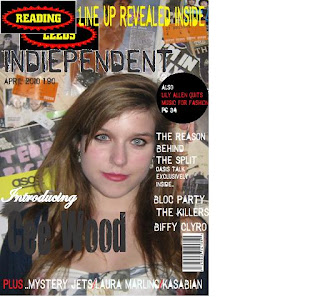
After completing my project I created a questionnaire where my audience could give me feedback on how they thought the final magazine pages looked. From this I concluded that on average they gave the magazine a 7 out of 10, they liked the way the front cover contrasts the double page spread and something they disliked was that it was mainly female orientated. Therefore if I was to make this magazine again I would include more images of male artists as my primary audience is predominantly male.
The three images on the left show my final magazine front cover, contents page and double page spread. Throughout the production stage I developed my Photshop skills as previously I had only ever used it for graphic design. From my initial front cover layouts I designed I think my final cover hasn't changed that much which is one thing that I think worked out well. If I was to do this project again I think I would organise the photoshoot better as I didn't have an SLR camera which compromised the quality of my final photo's. As you can see from the image I have kept to the conventions of a music magazine such as a big splash image on the front cover, the use of plugs and the colour of the font which is a mixture of black, white and red. From my research feedback just over the majority of my audience said that the front cover would encourage them to buy the magazine however the ones who said it wouldn't said this because they didnt think the image stood out enough and didn't catch their eye.
From my initial ideas and contents layout the final contents page has changed slightly as another image has been placed on the left hand side. I did this last minute so had to re-size the font and re-arrange the page slightly. I stuck to the layout I designed originally and included the website at the bottom as a way of advertising it within the magazine. This is the page out of all three that I am most happiest with as its simple and easy to read and I like the typography, images and colours used however if I was to do this project again I would list more articles for the magazine and probably add another image.
This is my final double page spread which is exactly the same as I planned it which is something im happy with. There wasn't enough room for me to fit my whole double page spread article I wrote on the left hand side of the page so I had to select certain questions to include. From my audience feedback questionnaire I was able to find that they criticised the double page spread for not having enough content evne though I struggled to fit in as much as I did, but some of the audience did say that they thought what content was there was easy to read and enagaging. If I were to make this page again I would either use a smaller font or change the style of article so I could fit more of it in which would appeal to the audience greatly.
Overall, throughout the magazine project I feel as if my skills have developed and improved greatly. I had to overcome many obstacles in the construction process such as the skin looking too airbrushed and once the red eye had been removed it made the models eyes look unnatural. Once completing the task it made me realise how important and influential audience research is as without it you could end up choosing things to include in your magazine which you wouldn't appeal to your target market. So if I were to do this again I would probably create more questionnaires or another mood board so I had more audience research to work from. Another thing I would do would be to challenge the conventions of music magazines as it would give my magazine an advantage above others as it would include something different and unexpected. When it comes to the final pages I really wasn't happy with the front cover as I don't think it looks professional enough and could be improved greatly by changing a few things such as the font styles. I was quite pleased with the contents page overall but on the double page spread I would have liked to have been able to include more content from the article I had previously written but there wasn't enough room on the page. Therefore if I were to complete these pages over again I would make those changes as it would improve the look of the whole magazine.













